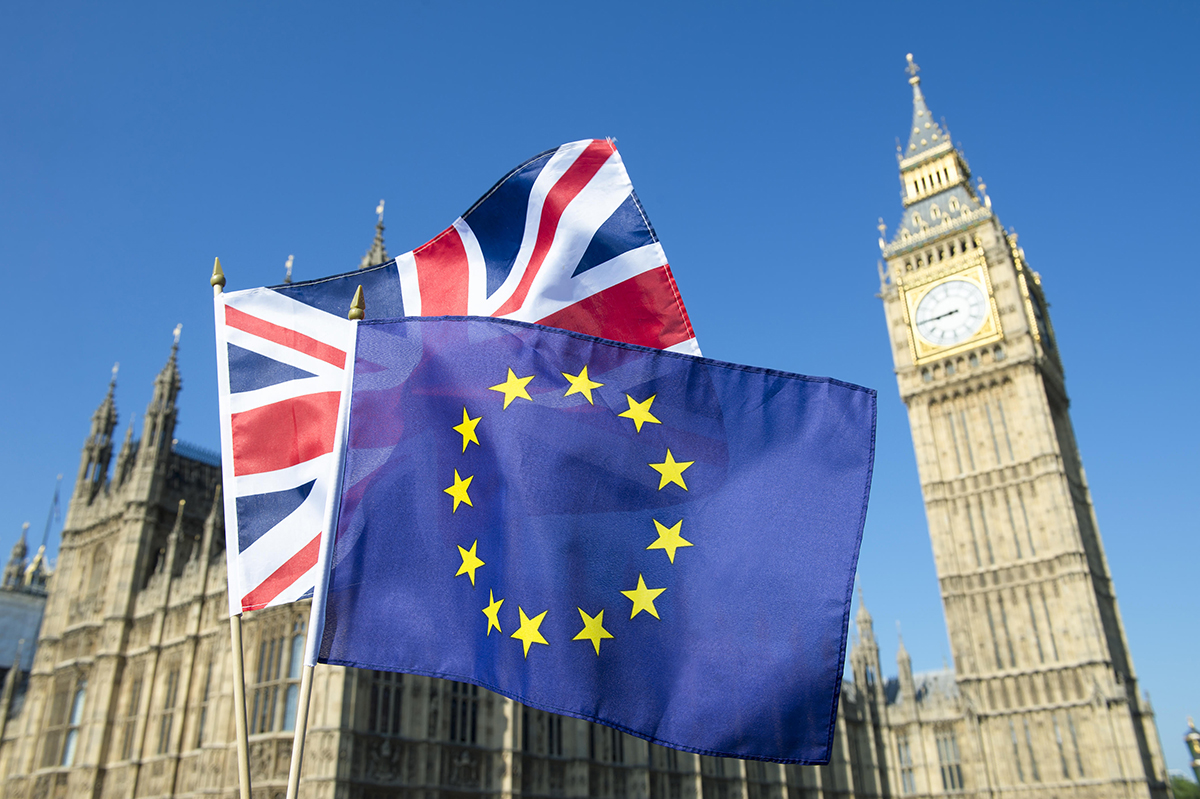Brexit
The Case for a Second EU Referendum
The fate of the withdrawal agreement, and indeed the country at large, cannot depend on “he said, she said” accusations and counter-accusations.

There is a great deal of talk in Britain at the moment about a “People’s Vote”—a referendum on the terms of the withdrawal agreement between the UK government and the EU, with an option to remain in the EU. It was predictable in June 2016 that sooner or later minds would focus on the terms of the agreement that would need to be reached as part of the process when the British government triggered Article 50, the clause of the Treaty on European Union that enables member states to secede. One of the advantages of the time-limited nature of the Article 50 process is that it means the issue cannot be delayed indefinitely.
This focusing of minds has, unsurprisingly, led to widespread calls for a “People’s Vote.” It is equally unsurprising that the proposal should encounter stiff resistance. Many voters were led to believe, not least by the British Government, that their vote in the 2016 referendum would settle the matter of the UK’s EU membership once and for all. Against that backdrop, many people (including some who voted Remain) consider that another vote is an attempt to reverse the result of the first referendum.
Those arguing for a “People’s Vote” need to be clear as to the rationale for it. There are, broadly speaking, three such rationales. In my view, only one of them is robust.
First Rationale: The 2016 Leave Campaign
First, there is the rationale based on the alleged irregularities of the 2016 “Vote Leave” campaign, such as misinforming the public about the likely financial benefits of leaving the EU and exaggerating the risk of the EU being enlarged to include Turkey. However, this rationale won’t wash, no matter how strongly people feel, as I do, that the Leave campaign was dishonest.
Arguing for a second referendum because statements made by the Leave campaign were factually incorrect has the smell of seeking to re-argue the very same issues that were debated (no matter how inadequately) in 2016. In addition, many Brexiteers feel just as strongly, although in my view mistakenly, that the Remain campaign was equally dishonest. The fate of the withdrawal agreement, and indeed the country at large, cannot depend on “he said, she said” accusations and counter-accusations.

Second Rationale: Breaches of Electoral Law in 2016
The second rationale is that the Leave campaign broke the law by exceeding its spending limits. The UK Electoral Commission, in its July 2018 report, found that expenditure by the BeLeave organization of £675,000 on online advertising was made under a “common plan” with Vote Leave, and that as a result Vote Leave exceeded its legal spending limits. The Electoral Commission did not merely conclude that this was likely to be true on the balance of probabilities, but true beyond a reasonable doubt. (Editor’s note: This ruling is being appealed by Vote Leave and BeLeave.)
The difficulty with this rationale is that it must be understood either in legal or political terms, and it does not quite work in either. As a matter of law, the breach of the spending rules does not entail that the referendum is void and without effect. Had the referendum been binding, and formed a cog in statutory machinery leading inexorably to the UK’s departure from the EU, then the breach of electoral law could have had the effect of invalidating the whole process. But the vote was only “advisory,” which is to say the UK Government was not legally bound to respect its result, so that argument doesn’t work.
And as a stand-alone political rationale for a second referendum, this doesn’t work either. Problems with the first referendum do not by themselves justify a second, and different, referendum. Nonetheless, there is no reason why it should not be seen as a relevant factor by members of the UK Parliament in deciding whether a second referendum ought to take place.
Third Rationale: From the General to the Specific
A good starting point in articulating the third rationale for the “People’s Vote” is an academic article by the political philosopher Brian Barry titled, ‘Is Democracy Special?’ published in 1979 and now gathering dust in an out-of-print book, Democracy and Power, Essays in Political Theory (1991).
In that article, Barry was concerned with two things: the basic rationale for democracy as such, and the way in which voting mechanisms ought to reflect that rationale. The rationale for democracy, according to Barry, is the “majority principle.” He illustrated this with a simple example. Suppose there are five people sharing a train carriage. They have to decide whether to permit smoking or not: an apparently logical and fair way of deciding the issue is by a majority vote.
So far, so (relatively) straightforward. Suppose that they have a vote on smoking, and the majority decide to prohibit smoking. Suppose also that there is another vote as to whether there ought to be a rule prohibiting passengers from listening to the radio and the result of the two separate votes is that there is a majority against both smoking and listening to the radio.
Barry points out that it would not follow from the above that if the passengers were asked to vote on both issues together they would come to the same conclusion. If the passengers were presented with four (combined) options—(a) pro-smoking and pro-radio, (b) anti-both, and (c) and (d) pro-one and anti-the other—it would not follow from the result of the two separate votes that they would choose (b) if the two issues were bundled together in a single vote. It is possible that none of the four combinations would command a majority. Indeed, it may be that the opposite combination (pro-smoking and pro-radios) would win a majority.
The moral of the story is that bundling matters. While radios and smoking do not have a great deal to do with each other, in the real world preferences on policies are inter-related. Sometimes, as Barry points out, policies complement each other. For instance, if one is to buy land and spend money constructing a building on it, it would be foolish to ask people to vote separately on the purchase of land and the expenditure. Other policies are in competition with each other: if money is spent on an expensive project X, that may exclude spending on expensive project Y. If you ask people to vote for projects X and Y in isolation, they may give a positive answer to both votes. However, a vote on the combination of those projects may be unpopular owing to their combined cost.
The key question, in the context of Brexit, is whether the terms of the withdrawal agreement and the decision to leave have a sufficiently close connection that they ought to be bundled together. In any view, the terms of the agreement are important in the Brexit process —no one denies that. In an ideal world, therefore, the terms of the agreement (and indeed the eventual trade deal) would have been pre-negotiated and then presented to the voting public in 2016 as part of a “bundled” option. But that was obviously impossible.
So we have a situation in which a referendum has been held and a version of Leave will be put on the table in the form of the withdrawal agreement. Is there now a rationale for a second vote, with Remain as an option? Note that the reason for including Remain on the ballot is the aforementioned bundling argument: it would bundle together the original question of whether voters wish to leave the EU with the question of whether they wish to leave on these particular terms.
On the face of it, the answer is yes. The point of democratic procedures is, in part, to determine what the majority preference is. If the majority prefers, having seen the withdrawal agreement, to remain in the EU, why should that majority not have an opportunity to express its preference by way of a vote?
The position is analogous to the following: My family collectively decides that we should eat out at a restaurant tonight, but on further investigation learns that the only restaurant open is one which no one likes. Accordingly, we decide to stay in. The first decision was based on a general question; the second on a specific one. The first decision was not overturned by the second, as it was always implicit that it may have to be tested by the specific options on offer.
Similarly, the question asked in the 2016 referendum was general: While Remain meant one thing, Leave meant a number of possible things. By contrast, the withdrawal agreement the government has negotiated is specific. It does not include the terms of the future trade agreement between the UK and the EU, but it does include provisions for payment of outstanding liabilities, for the rights of citizens, for the length of the transition period, and for the border in Northern Ireland (which has implications for the future trade agreement). It is this contrast between the general and specific which provides the most compelling argument for a second referendum.
The point can be tested as follows: Suppose that at the time of the 2016 referendum the terms of the withdrawal agreement had been pre-negotiated by the government, but were kept in a black box. Would it have made sense for the government in those circumstances to conceal the terms of that deal from the electorate and only open the box in the event of Leave winning? The question answers itself. Knowledge of those terms would not simply have been an added bonus; it would have been absolutely fundamental to the decision-making process.
It is worth noting that in those circumstances the choice on the ballot would have been between the withdrawal agreement and Remain. Leaving the EU without a deal—an option referred to as “No Deal” in this debate—would not have been on the ballot. It is only being touted as an option at the moment because the conveyor-belt process of Article 50 renders it a possible outcome.

First Objection to the Third Rationale: Too Simple
The dinner analogy does not capture the importance of the issue decided in the 2016 referendum. However, the example can be amended to include an important decision. Say that a family decides to make a drastic move: both parents will resign from their jobs and apply for new jobs abroad in a bid to start a new life. This is clearly an important decision. It is also the kind of decision which it would be entirely rational to re-assess once the specifics of the new jobs are known.
Second Objection: 2016 Decision Absolute and Unconditional
The decision taken in 2016 must be interpreted as absolute and unconditional. That is the view adopted by Thomas Simpson, associate professor of philosophy and public policy at Oxford University. In an article titled “The Ethics of a Second Referendum” he writes:
Any second referendum could offer only the choice between the deal on the table, and leaving with no deal. The decision on Brexit has already been taken. Choosing between leaving with or without a deal is the only way that another referendum could be held in a way that respects democracy.
Simpson does not offer any arguments for the above proposition, but presents it as if it was self-evident. Indeed, he claims that anyone who suggests a “People’s Vote” with an option to Remain is acting in “bad faith.” He states that “arguments in favour of a second referendum are so embarrassingly poor that it unduly dignifies them and their proponents to have to reply.” He does not address the issue of why a choice between the withdrawal agreement and “No Deal” would be a better way of ascertaining the majority preference than a choice which includes Remain. This could only be the case if those who voted Leave in 2016 were, or are assumed to be, completely indifferent to the terms of an exit from the EU, a position that cannot be described as self-evident. Merely stating, as he does, that there is an “obvious incompatibility of [holding a People’s Vote] with democracy” is not convincing.
He also puts forward the view that “The UK’s membership of the EU is a paradigm example of an issue that may be settled by referendum.” In other words, the in-out-referendum based on a simple majority vote was perfectly suited to “settle” the issue of EU membership. But this is far from self-evident. In the constitutions of the US and Germany, amending the constitution requires more than a simple majority. This is because constitutions are, as the Germans put it, “basic law,” so changing them should be more difficult that passing less foundational laws.
Some of the more intellectually sophisticated Brexiteers recognize this. Theodore Dalrymple, who voted Leave, wrote in June 2016:
Among the many subjects not properly discussed during the campaign was whether large and fundamental political changes should be made based on 50 percent-plus-one of the votes cast in a single plebiscite… [MPs] could argue, not without plausibility, that a vote representing no more than three-eighths of the total electorate isn’t quite the groundswell of opinion that should be required for fundamental change.
I mention this not in order to rake over old ground, but to make an important point: Section 1(1) of the EU Referendum Act 2015 simply provided that “a referendum is to be held on whether the United Kingdom should remain a member of the European Union,” and left it at that. The referendum was advisory, and the 2015 Act did not lay down any criteria by which the advice was to be evaluated. As David Lidington, the Minister of State for Europe, put it in the Parliamentary debate on the Referendum Bill: “What this legislation is about is holding a vote: the legislation makes no provision for what follows, and the referendum is advisory.” He added that there is “no threshold for the interpretation of the result.”
Parliament could have specified how large a majority would be needed in order to win (possibly with other variables included, such as voter turnout) and made the result binding. But it did not. It left it open as to how the government should interpret and respond to the result. The fact that the terms of the 2015 Act were extraordinarily open-ended—and intentionally so – provides support for a People’s Vote. For it means that Parliament chose not to be automatically bound by the result of the 2016 referendum, or indeed commit itself to any view of how that result should be interpreted or acted upon.
Simpson tell us that “the result of a referendum is binding, at least politically, and for anyone who pretends to be a democrat.” This is not only incorrect but dangerous. In a society governed by the rule of law, the law must be respected and complied with. If the result of referendum was not legally binding, there is no room to interpret it as “politically” binding. In any event, Simpson ought to be careful what he wishes for. For if the referendum result was binding, it would follow, for the reasons given above, that breaches of electoral law would have rendered it null and void.
Third objection: Parliament Did Not Provide for a Two-Stage Process
If, as I have argued, a second referendum once the terms of the withdrawal agreement are known is in keeping with the spirit of the 2015 Act, why did it not expressly provide for a two-stage process whereby an initial Leave vote would have to be followed by a further referendum on the withdrawal agreement?
The short answer is that it didn’t need to. For one thing, it was entirely possible that the Withdrawal Agreement would have been popular in the country at large. In that eventuality, a People’s Vote would not have been necessary. It is difficult for Brexiters to deny this possibility, given that they argued strongly during the 2016 referendum that the U.K. would be well placed to negotiate a beneficial agreement with the EU. Note that when the U.K. courts interpret Acts of Parliament, they do not consider the actual thoughts, wishes or indeed intentions of MPs. The courts simply consider the words on the page, and ignore all the rest. Statutory interpretation thus involves a necessary element of speculation. My point is that it cannot be inferred from the absence of a two-stage process in the 2015 Act that Parliament ruled out a referendum on the Withdrawal Agreement. The more natural inference to be drawn from the open-ended terms of the Act is that it kept all the options on the table.
Some Brexiteers have argued that if the withdrawal agreement had been subject to approval by a second referendum in which Remain was on the ballot, this would have undermined the UK’s negotiating position by incentivising the EU to offer it a bad deal in the hope that Remain would prevail second time around. I do not accept this argument, but if it is correct it follows that there was a pragmatic reason for parliament not to legislate for a two-stage process and the fact that it did not does not mean that holding a second referendum would be contrary to the spirt of the 2015 Act.
Fourth Objection: the ‘No Deal’ Dilemma
A “People’s Vote” gives rise to the question of whether “No Deal” ought to be on the ballot. If it is, there is a possibility that it might win, and many Remainers, myself included, think the consequences of a “No Deal” Brexit would be catastrophic. But if “No Deal” isn’t on the ballot to guard against this risk, some Brexiteers will feel cheated.
In the context of the issue I am discussing in this article—the legitimacy of a “People’s Vote”—“No Deal” would, like the withdrawal agreement, have the merit of appearing specific. However, it is a good deal less specific than the simple-sounding words “No Deal” imply. Would such an option would have the effect of preventing the government from seeking to conclude another withdrawal agreement on different terms? Would the government be prevented, in the event of a “No Deal” vote, from seeking agreement on some, but not all, of the areas covered in the withdrawal agreement? One of the lessons of the 2016 referendum is that clarity should be a paramount consideration, and “No Deal” would not, in itself, be completely clear.
Even if that issue can be overcome, another argument against including “No Deal” on the ballot is that if the UK left the EU without a deal it would be violating the terms of the Good Friday Agreement between the different political parties in Northern Ireland and between the UK and the Republic of Ireland. Under the terms of that agreement, there can be no hard border between the UK and Ireland, and one of the dangers of “No Deal” is that it might create just such a border. If it did, that would not only risk the re-emergence of the conflict between Protestants and Catholics in Northern Ireland, it would also damage the UK’s international reputation as a state that honors its treaty obligations.
It is a telling that “No Deal” advocates in parliament are not campaigning for a second referendum in which “No Deal” is on the ballot. Rather, they propose to vote down the withdrawal agreement on the basis that “No Deal” will follow by default if the Article 50 process is not suspended. If they thought “No Deal” was an option they could sell to the public, they ought to be pushing for a second referendum with “No Deal” as an option.
Fifth Objection: Betrayal and Civil Unrest
One of the most popular arguments against a “People’s Vote” is that it would create a sense of betrayal amongst those who voted Leave in 2016 and were led to believe their vote would be final and that in turn could lead to civil unrest, particularly if the outcome of a second referendum is a victory for Remain.
It is true that the British government told the electorate that it would treat the result as final. However, those assertions (quite apart from contradicting the assertions it made to parliament) were based on the assumption that the government would be within its legal rights to trigger Article 50 and conclude a withdrawal agreement without parliamentary approval. That assumption has been shown to be incorrect in the Supreme Court case R (Gina Miller) v Secretary of State for Exiting the EU [2017] UKSC 5, which made it clear that only parliament has the power to trigger Article 50 (which parliament duly did). It has since been conceded by the government that parliamentary approval will also be needed for the Withdrawal Agreement. The Government was thus, in 2016, promising something that it did not (unbeknownst to it) have the legal power to deliver. Parliament, which does have the power to control the Brexit process, made no such pledges. On the contrary, in the 2015 Act it refrained from making any promises at all.
The key question with regard to issue of betrayal is not, “Would people feel betrayed if there was a ‘People’s Vote?’” but “Would they be justified in feeling so betrayed?” For the reasons set out above, they would not.
Conclusion
Rightly or wrongly, referendums have been used in the past to decide some very important issues, such as whether a new nation state should be carved out of an existing one. The 2016 referendum was fundamentally different, in that leaving the EU is something that can be done in a number of fundamentally different ways. It follows that, if the referendum process was an appropriate decision-making tool to start the process, it is also appropriate to end the process. MPs should therefore have a clear conscience in putting the issue back to the people through a “People’s Vote” when an opportunity to vote on the matter arises, as it surely will in the next few weeks.






